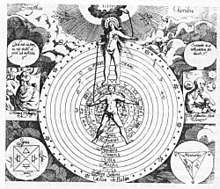Macrocosm and microcosm
Macrocosm and microcosm refers to a vision of cosmos where the part (microcosm) reflects the whole (macrocosm) and vice versa. It is a feature present in many esoteric models of philosophy, both ancient and modern.[2] It is closely associated with Hermeticism and underlies practices such as astrology, alchemy and sacred geometry with its premise of "As Above, So Below".[3]


The philosophy was conceptualized by Pythagoras, who saw the cosmos and the body as a harmonious unity.[4] The idea was re-articulated about a century later by Plato,[5] and again during the Renaissance, by Leonardo da Vinci, who noted common features between the natural world and the human body such as the circulation of liquids and basic branching mechanisms.[6]
In modern sociology, the concept of microcosm has been predominantly used to describe a small group of individuals whose behavior is typical of a larger social body encompassing it. A microcosm can be seen as a special kind of epitome. Conversely, a macrocosm is a social body made of smaller compounds. In physics, scale invariance describes the same phenomenon.
See also
References
- Robert Fludd in Utriusque Cosmic Historia, II; quoted by Pierre A. Riffard in Dictionnaire de l’ésotérisme, Paris: Payot, 1983, 34.
- Pierre A. Riffard, Dictionnaire de l’ésotérisme, Paris: Payot, 1983, 34.
- Antoine Faivre, Access to Western esotericism, State University of New York Press, 1994, 10-11.
- Garber, James J. (2017-07-28). Harmony in Healing. pp. 15–16. doi:10.4324/9780203790281. ISBN 9780203790281.
- McDonough, Richard. "Plato: Organicism". Internet Encyclopedia of Philosophy. Retrieved 6 September 2019.
- Wallace, Robert (1972) [1966]. The World of Leonardo: 1452–1519. New York: Time-Life Books. p. 103.
Further reading
- Theories of Macrocosms and Microcosms in the History of Philosophy, G. P. Conger, NY, 1922, which includes a survey of critical discussions up to 1922.
- Plato, Republic, trans. By B. Jowett M.A., Vintage Books, NY. § 435, pg 151
External links
| Wikisource has the text of the 1921 Collier's Encyclopedia article Microcosm and Macrocosm. |
- Cosmos - an Illustrated Dimensional Journey from microcosmos to macrocosmos - from Digital Nature Agency